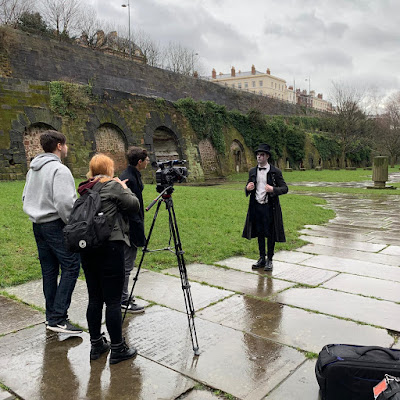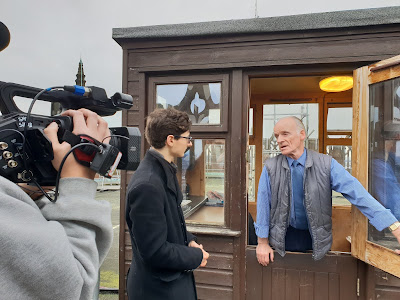Therefore, the whole shooting took place inside and around the district, aiming for an overall view of the Georgian Quarter's luxurious 18th-century buildings, an in-and-out image of the biggest cathedral in Liverpool, 5th in world, and a detailed tour of Shiverpool about the hidden meanings and stories in the maritime city.
I had the main position of the director and secondly, the sound mixer and the cameraman. Being the director was a tough job, since Amy and Tom won't listen to me the times I tried to kindly tell them what would be the best to be done, but I still believe that my creativity, passion and eager eyes helped the entire footage to be facile to read through it and for the meaning behind it to be understood. In Liverpool, I've spent my time mostly staying closer to the camera operators, trying to see through the camera's lens, but also outside of them, having a clean and precise perspective of the surroundings in this way. On the the post-production session, I paid close attention to what the editors were doing and gave them guidance where needed.
My vision was to create an observational documentary with expressive moving images, using GVs and close-ups mainly (speaking of the visual aspect of the film), along with a voiceover that could complete the story written in the imagery (interviews and narrator) and that will enrich our narrative in the documentary, simultaneously.
 |
| Photo taken by Chloe Daniels |
Unfortunately, because I had to hurry up a bit in order for the shooting not to start out late, I didn't have time to think of the gaffer tape I bought previously, which would've been a life saver if we had used it to stop the friction of the mic with the clothes. However, after listening to the audio on the laptop, luckily there are only a few bits with a distorted sound, which I believe can be fixed with ProTools.
Still speaking of sound mixing, Dominic thought that he was the most suitable to be a narrator. Therefore, we met a few times afterwards the Liverpool trip and I helped him record his voice with the usage of a lavalier, audio that is going to be examined and then used later in the post-production.
Another issue we sadly encountered during the pre-production, which continued until the very end, was represented by the lack of teamwork, me and Dominic having to do almost everything, since our teammates seemed too bored or tired most of the time, in spite of the fact that we tried to communicate and induce them prior the shooting days the importance of cooperation and hardworking. However, they accompanied us and helped us by carrying the equipment required on each day, but because Tom's footage of the Georgian Quarter wasn't enough, Dominic and I decided to shoot separately and leave the post-production team with more possibilities in this way.
When we started the editing part, I helped in both image and sound with a few ideas of how the footage can be used in the documentary in order to make them understand my vision upon it or gave guidance to Jake, the sound editor, on how to use the ProTools' settings properly.
Moreover, I fixed the audio from the interviews and from Tom's footage, the audio levels on the mother project, color corrected the footage, included and edited the title and the original credits that can be seen below.
The actual final version, after 2 days of working on it myself, can be watched on this link: https://drive.google.com/open?id=1DsScLJmXgb5teQoCvTaU-MWlLfE-iS_1 I am not assuming that it's perfect, but after she saw this, she just wanted to change the things I did just for the people to know that it's her work and it solely has her touch on it.
Furthermore, for a precise and correct evaluation, I wrote down the ending credits that will be included later in the post-production session.
Sadly at that time, we were still trying to figure out a way to get copyrights of an artist, ideally from Paul McCartney. However, I decided that it will be good if we will use a copyright free song from Youtube when only the credits are displayed.

In addition to everything that I mentioned above, in order to help the producer with the paper work, I decided to get hold of the consent forms for the interviewees myself and hand them in to Dominic before leaving to Liverpool.
→All photos displayed above (except of the one specified) are taken and uploaded by me.































